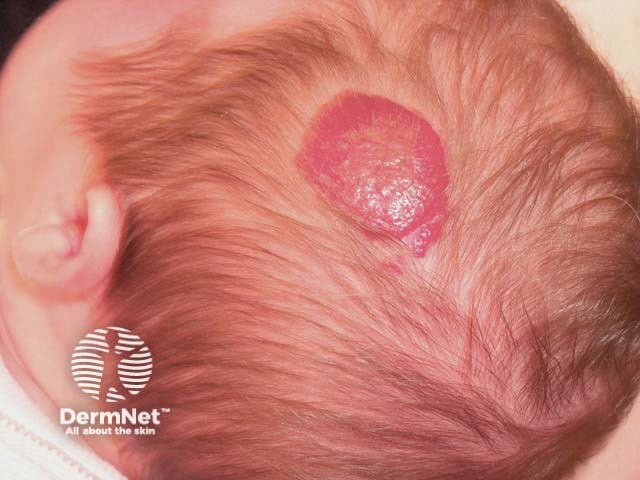Main menu
Common skin conditions

NEWS
Join DermNet PRO
Read more
Quick links
For each of the ten cases, study the image(s) and then answer the questions. You can click on the image to view a larger version if required.
Each case should take approximately five minutes to complete. There is a list of suggested further reading material at the end of the quiz.
When you finish the quiz, you can download a certificate.

What is the name and nature of the lesion?
This is a superficial haemangioma, commonly known as a strawberry naevus. Acquired proliferative haemangiomas affect 10% infants, arising more frequently in females (ratio 3:1) and pre-term infants (22% of those weighing under 1000g). They are multiple in 20% of cases, 60% arising on the head and neck. They grow rapidly because of neonatal angiogenic growth factors, starting within a few months of life reaching a peak at about a year.
What management would you recommend?
Regular review. Most haemangiomas do not require treatment. Nearly all haemangiomas undergo complete involution by age 10-12 years. Minor scarring, telangiectasia or excess fibrofatty tissue may remain.
What should prompt you to refer to a specialist?
Apart from referring to a specialist for parental reassurance, the following features of haemangiomas may necessitate intervention: uncontrolled bleeding or ulceration; severe aesthetic deformity or residual disfigurement; functional complications e.g. lesion occluding lip, eyelid, nose; platelet trapping coagulopathy (Kasabach-Merritt syndrome) with very large haemangiomas. The choice of specialist may depend on where the lesion is located.
What treatment is available?
The following measures are rarely used: systemic steroids to control proliferation; flash lamp pulsed dye laser to lighten the colour; surgical excision, most often to remove residual redundant tissue. Recombinant interferon alfa-2a is no longer recommended because of serious complications including spastic diplegia.